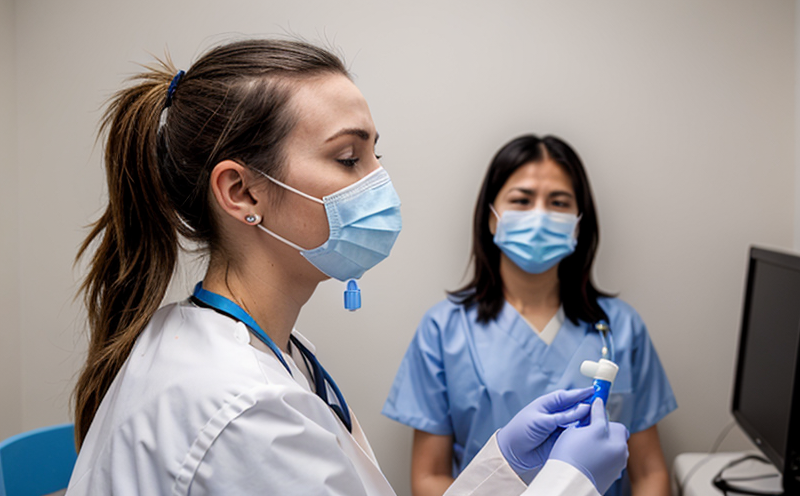Respiratory Disease Testing
The field of respiratory disease testing is a critical component in medical diagnostics and public health. Respiratory diseases encompass a wide range of conditions affecting the lungs, bronchi, trachea, and other parts of the respiratory system. These conditions can be caused by various factors including infections (bacterial, viral, or fungal), environmental allergens, genetic predispositions, and chronic inflammation.
Respiratory disease testing plays a pivotal role in early detection, accurate diagnosis, and effective treatment planning for patients suffering from these ailments. The process involves multiple steps ranging from the initial specimen collection to the final analysis of test results. Specimen types can include sputum, bronchoalveolar lavage fluid, blood, or induced sputum samples.
Key tests within this category include spirometry for measuring lung function, arterial blood gas (ABG) testing to assess oxygenation and acid-base balance, and various microbiological cultures and serological assays designed to identify specific pathogens. Respiratory disease testing also includes imaging techniques such as chest X-rays or CT scans which provide visual insights into the structural integrity of the lungs.
Accurate and reliable respiratory disease testing is essential for both clinical care and public health measures. It helps healthcare providers make informed decisions about patient management, enabling personalized treatment approaches that improve outcomes while minimizing unnecessary exposure to treatments. Properly conducted tests also contribute significantly towards understanding epidemiological trends which inform policy development aimed at preventing further spread of infectious agents.
Standards like ISO 15189 and EN ISO 17025 guide laboratories performing respiratory disease testing ensuring they adhere to stringent quality control measures throughout all stages of the analytical process. By leveraging these standards, laboratories can ensure consistent accuracy across their results thereby enhancing patient trust and confidence.
As technology continues to evolve so too does our ability to refine respiratory disease tests offering more precise diagnoses than ever before. Advances in molecular biology have led to highly sensitive detection methods capable of identifying even small amounts of genetic material from pathogens responsible for causing diseases such as tuberculosis or pneumonia. Additionally, portable diagnostic devices are becoming increasingly available allowing rapid point-of-care testing which can significantly reduce turnaround times for results.
In summary, respiratory disease testing is an integral part of modern healthcare delivery systems providing crucial information necessary for effective patient care and public health initiatives alike. Its importance cannot be overstated given its direct impact on improving quality of life for individuals diagnosed with respiratory conditions as well as broader societal benefits stemming from reduced hospital admissions and improved overall population health.
Benefits
- Early detection and diagnosis of respiratory diseases leading to better patient outcomes.
- Precision in identifying pathogenic agents contributing to more targeted therapies.
- Improved understanding of disease progression patterns facilitating preventive measures.
- Enhanced accuracy through adherence to international standards ensuring consistency across different laboratories.
- Reduced hospital stays due to timely and accurate diagnosis enabling appropriate discharge plans.
Quality and Reliability Assurance
- Laboratories must comply with ISO 15189 accreditation which ensures robust quality management systems.
- Adherence to EN ISO 17025 standards guarantees competence for conducting testing services.
- Regular proficiency testing using certified reference materials maintains high levels of analytical performance.
- Implementation of standardized operating procedures reduces variability in test results enhancing reliability across all samples processed.
Use Cases and Application Examples
In clinical settings, respiratory disease testing is frequently employed for diagnosing conditions such as asthma, chronic obstructive pulmonary disorder (COPD), bronchitis, and pneumonia. It also plays a vital role in monitoring patients undergoing treatment to assess response efficacy.
Public health organizations utilize these tests extensively during outbreaks of infectious diseases like influenza or SARS-CoV-2 to track prevalence rates and inform intervention strategies. For example, widespread screening programs have been implemented globally during recent pandemics enabling rapid identification and containment efforts.
Research laboratories also rely heavily on respiratory disease testing when studying the mechanisms behind these illnesses aiming to develop new treatments or vaccines. By rigorously analyzing samples from infected individuals alongside healthy controls, scientists gain deeper insights into pathophysiology which ultimately drives innovation in medical science.





